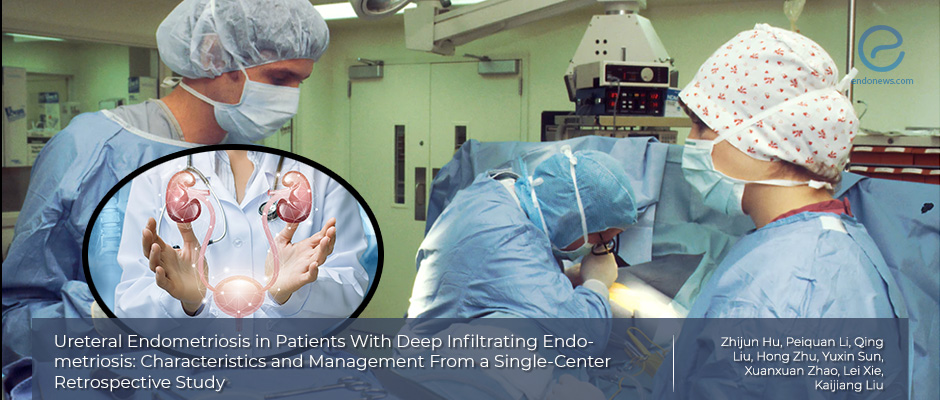Risk Factors Associated with Ureteral Endometriosis
May 28, 2020
A new study identifies factors associate with the risk of urethral endometriosis and outlines the feasibility and safety of two surgical procedures.
Key Points
Highlights:
- Severe endometriosis, uterosacral ligament deep infiltrating endometriosis lesions of more than 3 cm in diameter, and previous surgery for endometriosis are all factors that significantly increase the risk of the presence of ureteral endometriosis.
- Laparoscopic ureterolysis and ureteroneocystostomy are safe and complication rates are low.
Importance:
- These knowledge direct surgeons for informed choices when treating women with endometriosis.
What's done here:
- Researchers performed a retrospective case-controlled study where they analyzed the outcome of laparoscopic ureterolysis and ureteroneocystostomy used to treat ureteral endometriosis.
Key results:
- Severe endometriosis was more common in patients with ureteral endometriosis compared to those without (55/68 vs. 168/261)
- Uterosacral ligament deep infiltrating endometriosis lesions ≥ 3 cm were more frequently identified in patients with ureteral endometriosis compared to those without (52/68 vs. 110/261).
- Patients with ureteral endometriosis had more dysmenorrhea, lumbago, and hematuria.
- Patients with ureteral involvement were generally reoperated patients for endometriosis compared to patients without ureteral endometriosis.
- Deep infiltrating endometriosis lesions in the rectum and obliteration of the cul-de-sac were more frequently identified in the patients with ureteral endometriosis than in those without.
- Ureteral endometriosis did not recur, at least for two years, following ureterolysis and ureteroneocystostomy.
Limitations:
- The number of patients analyzed is low and the follow-up period is short.
Lay Summary
Patients with severe endometriosis, uterosacral ligament deep involvement with endometriosis lesions of 3 cm in diameter or more, and the presence of previous endometriosis surgery have a significantly higher risk of having ureteral endometriosis. This is according to a study published in the Archives of Gynecology and Obstetrics.
The authors of the study also suggest that laparoscopic ureterolysis and ureteroneocystostomy are both safe and have a low complication rate with low endometriosis recurrences.
These findings are important because they allow surgeons to decide on the best course of action to treat deep infiltrating endometriosis as well as ureteral endometriosis.
For the study, a team of researchers led by Dr. Kaijiang Liu at Shanghai Jiao Tong University in China analyzed 329 patients with deep infiltrating endometriosis. All patients were treated with laparoscopic surgery. The researchers divided the patients into two groups based on whether or not they had ureteral endometriosis. This meant that there were 68 patients in the first group, with ureteral endometriosis, and 261 in the second group without ureteral endometriosis. Thirty-seven of the patients who had ureteral endometriosis had had hydroureteronephrosis or the swelling of a kidney due to trapped urine.
Severe endometriosis, stage 4 as per the criteria of the American Fertility Society, was more common in patients with ureteral endometriosis than in those without (55 out of 68 patients versus 168 out of 261 patients)
Similarly, uterosacral ligament deep infiltrating endometriosis lesions of 3 cm or larger were more frequently identified in patients with ureteral endometriosis compared to those without; namely in 52 of the 68 patients with ureteral endometriosis and in 110 of the 261 patients without.
Patients with ureteral endometriosis had more dysmenorrhea, lumbago, and hematuria, but this was statistically less significant.
Previous surgery for endometriosis was more often performed in patients in the ureteral endometriosis group than in those in the non-ureteral endometriosis group.
After statistical analyses, the researchers concluded that having endometriosis stage 4, uterosacral ligament deep infiltrating endometriosis lesions of at least 3 cm in diameter, and previous surgery of endometriosis significantly increase the risk of ureteral endometriosis. The researchers then focused on surgical variables.
Fifty-nine of the patients who were analyzed in this study had had ureterolysis and nine had had ureteroneocystostomy. Ureterolysis is a surgical procedure that frees the ureter, or tube that carries urine from the kidneys to the bladder, from any tissue that is pressing on it. This way, urine is allowed to flow down to the bladder instead of back flowing to the kidneys potentially causing hydroureteronephrosis. Ureteroneocystostomy is the re-implantation of the ureter into the bladder.
None of the patients who have had the urethral surgeries had a recurrence of ureteral endometriosis following the procedures when checked after two years.
The authors concluded that ureterolysis and ureteroneocystostomy are both feasible and safe with low complication and recurrence rates.
Research Source: https://www.ncbi.nlm.nih.gov/pubmed/31494695
deep infiltrating endometriosis ureteral endometriosis stage 4 endometriosis severe endometriosis laparoscopic surgery risk factors ureterolysis; ureteroneocystostomy pouch of Douglas abdominopelvic cavity cul de sac

